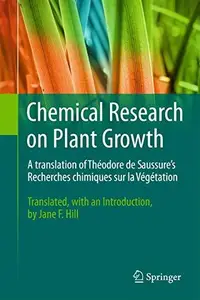- Témaindító
- #1
- Csatlakozás
- 2024.09.10.
- Üzenetek
- 40,672
- Reakció pontszám
- 8
- Díjak
- 5
- Kor
- 37

Free Download Chemical Research on Plant Growth: A translation of Theodore de Saussure's Recherches chimiques sur la Vegetation By Théodore de Saussure (auth.)
2013 | 192 Pages | ISBN: 1461441358 | PDF | 2 MB
Recherches Chimiques sur la Végétation was a seminal work in the development of the understanding of photosythesis and plant chemistry. The original publication, which was the first concise summation of the basics of plant nutrition, was a landmark in plant science. It was twice translated into German during the nineteenth century, but no English translation has been published. This translation will interest those in the plant, chemical, agricultural, and soil sciences, and the history of science, who find English more accessible than French or German and who wish to learn more about the early research on photosynthesis and plant science. Nicholas-Théodore de Saussure, a Swiss plant physiologist and plant chemist, was the last of the early pioneers of photosynthesis research. This initial period of research is generally considered to have begun with Jan van Helmont in the early seventeenth century and Stephen Hales in the first part of the eighteenth, then to have become more intense with Joseph Priestley, Jan Ingen-Housz, and Jean Senebier during the Scientific Revolution of the mid-to-late eighteenth century. Nicholas-Théodore's father, the famous Swiss geologist, meteorologist, and Alpine explorer Horace-Bénédict de Saussure, had been an early convert to the new chemical theories pioneered by Antoine Lavoisier in the late eighteenth century. Nicholas-Théodore, younger than his predecessors, had the full advantage of this new approach, which stressed quantitative chemical methods. Applying these methods to plants, Nicholas-Théodore de Saussure performed experiments that led him to major insights into plant nutrition. His most important contributions were the demonstration that water is a component of plant dry matter; that plants obtain their carbon from the carbon dioxide of the air, not from carbonic acid dissolved in the soil water, as most of his contemporaries believed; and that mineral elements and nitrogen from the soil are essential to plant growth. Further, he demonstrated the central fact of plant respiration (the absorption of oxygen and emission of carbon dioxide); and photosynthesis (the decomposition of carbon dioxide and evolution of oxygen in the light). In Recherches Chimiques sur la Végétation, de Saussure synthesized his own research findings with those of his predecessors, producing a pioneering work on plant nutrition. In the two centuries since Recherches Chimiques sur la Végétation was published, luminaries in various branches of science, including plant biology, chemistry, and soil science, have consistently praised it highly. In the nineteenth century, noted botanist Alphonse de Candolle and equally noted plant physiologist Julius von Sachs expressed great admiration for it. Although de Saussure's ideas were forgotten for a time, famed chemist Justus von Liebig, who invented artificial fertilizer, rediscovered them in the 1840s and brought them to the attention of the agricultural community, stressing their importance for increasing crop yields. In the twentieth century, eminent photosynthesis researcher Eugene Rabinowitch described Recherches Chimiques sur la Végétation as the first modern book on plant nutrition. Historian of chemistry Henry Leicester called the book a classic, noting that the first important generalization about biochemistry in the nineteenth century came from it. Plant physiologist P. E. Pilet stated that the book laid the foundations of a new science, phytochemistry. Soil scientist E. Walter Russell attributed to de Saussure the quantitative experimental method, which more than anything else made modern agricultural chemistry possible. Chemist Leonard K. Nash stated that de Saussure brought the studies of plant nutrition begun by Priestley, Ingen-Housz, and Senebier close to completion, finishing the basic experimental work and providing a convincing theoretical interpretation of the field, and also opened up new vistas of experiment and thought. A further note about the translation: This project is more than just a translation because it includes an extensive introduction as well as notes that provide explanations for archaic terminology and other background material.
Buy Premium From My Links To Get Resumable Support,Max Speed & Support Me
Code:
⚠
A kód megtekintéséhez jelentkezz be.
Please log in to view the code.
